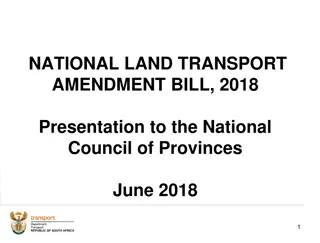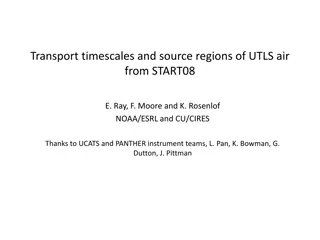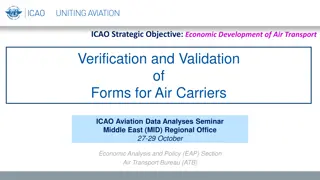Understanding Air Transport Statistics: Key Concepts and Definitions
Explore the world of air transport statistics with insights into economic development, classification of civil aviation activities, commercial air transport services, and distinctions between scheduled and non-scheduled operations. Learn about essential definitions related to commercial air transport operators, traffic, aircraft departures, and city-pair travel authorizations.
Download Presentation

Please find below an Image/Link to download the presentation.
The content on the website is provided AS IS for your information and personal use only. It may not be sold, licensed, or shared on other websites without obtaining consent from the author. Download presentation by click this link. If you encounter any issues during the download, it is possible that the publisher has removed the file from their server.
E N D
Presentation Transcript
ICAO Strategic Objective: Economic Development of Air Transport Introduction to Air Transport Statistics ICAO Aviation Data Analyses Seminar Middle East (MID) Regional Office 27-29 October Economic Analysis and Policy (EAP) Section Air Transport Bureau (ATB)
Main terms and definitions used in air transport statistics
Civil Aviation Activities Classification Commercial air transport services General aviation (GA) Airport services Air navigation services Civil aviation activities Civil aviation manufacturing Aviation training Maintenance and overhaul Regulatory functions Other activities
Civil Aviation Activities Commercial Air Transport Services Scheduled Commercial air transport services Charter Air taxis Commercial business aviation Non-scheduled On demand Others Others
Scheduled vs. non-scheduled Distinction very blurry in Europe and North America May distort annual growth figures In many other States distinction still exist Poor reporting of non-scheduled traffic Non-scheduled traffic difficult to estimate
Some definitions used in air carriers statistics Commercial air transport operator: An operator that, for remuneration, provides scheduled or non-scheduled services of passengers, freight or mail. Also includes small-scale operators, such as air taxis, that provide commercial air transport services. Operating carrier: Carrier whose flight number is being used for air navigation control purposes. All operational and traffic items should be reported, including code-shared, franchised, pooled, blocked-off charter, blocked-space arrangements, joint services and leased aircraft services. Traffic:For air transport purposes, traffic means the carriage of passengers, freight and mail.
Some definitions used in air carriers statistics Aircraft departures: Number of take-offs of aircraft. For statistical uses, departures are equal to the number of landings made or flight stages flown. City-pair: Two cities between which travel is authorized by: a passenger ticket or part of a ticket (a flight coupon) or a shipment document or a part of it (freight bill or mail delivery bill)
Some definitions used in air carriers statistics Distances: Aerodrome-to-aerodrome great circle distances should be used in all items involving distance Great Circle distance is defined as the shortest distance between two points on the surface of the Earth by using the Vincenty distance formula associated with the World Geodesic System 1984 (WGS 84) adopted by ICAO (Annex 15). The latitude and longitude of aerodromes can be taken from aerodrome data published in Aeronautical Information Publication (AIP).
Flight Stage Definition Flight Stage: the operation of an aircraft from take-off to its next landing International when one or both terminals are in the territory of a State, other than the State in which the air carrier has its principal place of business. Domestic when both terminals are in the territory of the State, where the air carrier has its principal place of business . Includes flight stages between the State and the territories belonging to it, and between two such territories. This applies even though a stage may cross international waters or over the territory of another State.
Domestic vs. International Illustration Carrier having an AOC from another State than A Carrier having an AOC from State A International flight stage International flight stage State A State A State B State B Domestic flight stage Cabotage = International flight stage 10
Domestic vs. International Case for Territories A territory of State A is considered as being the State A International flight Domestic flight International flight State A International flight State A State B State B Domestic flight International flight Territory of State A International flight Territory of State A International flight Carrier having an AOC from another State than A Carrier having an AOC from State A 11
Definition of a Passenger All forms (except form C) Form C (only international scheduled traffic) If the flight coupon includes only international flight stage(s) Form C is traffic by flight stage: Each passenger is counted once on each flight stage If the flight coupon includes only domestic flight stage(s) 1 Passenger = a flight coupon Enable to compute the Revenue Passenger-kilometres (RPK) If the flight coupon includes both domestic and international flight stage(s) Same rules for the tonnes of freight carried 2 Passengers = a flight coupon 1 counted as domestic, 1 counted as international
Definition of a Passenger Illustration 1 Flight EK384 1 flight coupon DXB BKK HKG international stage international stage 1 flight coupon = 1 international passenger Note: except for form C definition
Definition of a Passenger Illustration 2 Flight AA959 1 flight coupon LAX NYC PAR domestic stage international stage 1 flight coupon = 1 domestic passenger +1 international passenger Note: except for form C definition
Definition of a Revenue Passenger Revenue passenger: a passenger carried for which the airline receives remuneration It includes passengers traveling: a) under publicly available promotional offers or loyalty programmes b) as compensation for denied boarding c) on corporate discounts d) on preferential fares (government, military, youth, student, etc.)
Definition of a Revenue Passenger Revenue passenger: a passenger carried for which the airline receives remuneration It excludes, for example: a) persons travelling free; b) persons travelling at a fare or discount available only to employees of air carriers or their agents or only for travel on business for the carriers; c) infants who do not occupy a seat
Definition of Revenue Passenger-Kilometres Revenue passenger kilometres (RPK) also called Passenger kilometres perfromed (PKP): one revenue passenger-kilometre means that one passenger is carried on one kilometre. RPK for an airline: Sum of the products obtained by multiplying the number of revenue passengers carried on each flight stage by the corresponding stage distance. The resultant figure is equal to the number of kilometres travelled by all passengers. ?????????? ??????? ?? ???? ? ????? ? (???????? ?? ???? ? ????? ?) ???? ? ????? ? It requires data by flight stage
Revenue Passenger-Kilometres Illustration Flight AA959 FRA LON NYC x2 x3 through LON NYC FRA x4 Computation of the RPK: the 1st step is to break down the data by flight stage FRA LON NYC x2 + x4 x3 + x4
Revenue Passenger-Kilometres Illustration Flight AA959 (broken down by flight stage) 5500 km 600 km FRA LON NYC x6 x7 Computation of the RPK: the 2nd step is to multiply the number of passengers by the distance on each flight stage ??????? ????????? ?????????? = ? ??? + ? ???? = ?? ???
Definition of Available Seat-Kilometres Available seat-kilometres (ASK): one available seat-kilometre means that one seat is flown on one kilometre. ASK for an airline: The sum of the products obtained by multiplying the number of seats available for sale on each flight stage by the corresponding stage distance. Seats not actually available for the carriage of passengers because of higher amount of fuel required or other payload/operational restrictions should be excluded from the calculations. ????? ????????? ?? ???? ? ????? ? (???????? ?? ???? ? ????? ?) ???? ? ????? ?
Available Seat-Kilometres Illustration Flight AA959 5500 km 600 km FRA LON NYC x10 x10 Computation of the ASK: multiply the number of seats by the distance on each flight stage ????????? ???? ?????????? = ?? ??? + ?? ???? = ?? ???
Definition of Passenger Load Factor Passenger Load Factor (PLF): the revenue passenger-kilometres as a percentage of the available seat-kilometres ??? ??? ??? =
Passenger Load Factor Illustration Flight AA959 5500 km 600 km FRA LON NYC x6 x7 x10 x10 ??? =??? ???=?? ??? ?? ???= ?.?? = ??%
Definition of Passenger Tonne-Kilometre Passenger tonne-kilometres for an airline: sum of the products obtained by multiplying the number of tonnes of passenger revenue load carried on each flight stage by the corresponding stage distance. ????????? ??????? ???? ?? ???? ? ????? ? (???????? ?? ???? ? ????? ?) ???? ? ????? ? Example for the calculation of the revenue load for 1 revenue passenger: Passenger revenue load = weight of the Passenger + weight of its checked baggage = 70 kg + 30 kg = 100 kg = 0.1 tonne When no data is available, 0.1 tonne is the standard weight suggested by ICAO for a passenger plus its baggage
Definition of Passenger Tonne-Kilometre Example for the calculation of the Passenger Tonne-Kilometre: 600 km 5500 km FRA LON NYC x6 x7 ????????? ????? ?????????? = ? ?.? ??? + ? ?.? ???? = ???? It is also equal to: ????????? ????? ?????????? = ??????? ??????? ???? ??? = ?.? ?? ??? = ????
Definition of Freight Tonne-Kilometre Freight tonne-kilometres: ????? ? ?????? ??????? ?? ???? ? ????? ? (???????? ?? ???? ? ????? ?) ???? ? ????? ? Example for the calculation of the Freight Tonne-Kilometre: 600 km 5500 km FRA LON NYC 0.5 tonnes of freight 0.7 tonnes of freight ??????? ????? ?????????? = ?.? ??? + ?.? ???? = ? ???
Total capacity available or Payload Capacity On each flight stage: Payload capacity for passengers = A = Number of seats available x average passenger revenue load Payload capacity for cargo = B = Volume available for cargo x cargo density Total Payload Capacity = C = A + B Recommendations: average passenger revenue load = Passengers mass + baggage = 100 Kg (ICAO/IATA) cargo density = 161 Kg / m3 (ICAO/IATA) Payload Capacity refers to the capacity available for saletaking into consideration: Payload restrictions Operational restrictions Marketing considerations
Definition of Available Tonne-Kilometre Available Tonne-Kilometre: ????? ???????? ?? ???? ? ????? ? (???????? ?? ???? ? ????? ?) ???? ? ????? ? Example for the calculation of the Available tonne-kilometre: 600 km 5500 km FRA LON NYC Total Payload Capacity = 2 tonnes Total Payload Capacity = 2 tonnes ????????? ????? ?????????? = ? ??? + ? ???? = ?? ???
Definition of Weight Load Factor Weight Load Factor (WLF): the total revenue tonne-kilometres as a percentage of the available tonne-kilometres ????????? ????? ?????????? + ????? ? ????? ?????????? + ???? ????? ?????????? ????????? ????? ?????????? W?? = ????? ????? ?????????? ????????? ????? ?????????? W?? =
Weight Load Factor Illustration Flight AA959 5500 km 600 km FRA LON NYC 0.6 tonnes of passenger revenue load 0.7 tonnes of passenger revenue load Payload 0.5 tonnes of freight 0.7 tonnes of freight Total Payload Capacity = 2 tonnes Total Payload Capacity = 2 tonnes Capacity ?.? + ?.? ??? + (?.? + ?.?) ???? ? ??? + ? ???? ? ??? ?? ???= ?.?? = ??% ??? = =
Aircraft Kilometres Illustration Aircraft Kilometres: ?????????? ??? ???? ? ????? ? (???????? ?? ???? ? ????? ?) ???? ? ????? ? Example for the calculation of the aircraft kilometres: 5500 km 600 km FRA LON NYC 2 departures 2 departures ???????? ?????????? = ? ??? + ? ???? = ?? ???
Aircraft hours Airborne hours Landing Take-off Block hours First movement of the aircraft Parking position
Some definitions used in air carriers statistics MCTOM: Maximum certificated take-off mass (MCTOM) (metric tonnes) according to the certificate of airworthiness, the flight manual or other official documents. Passenger revenue per traffic-unit (passenger yield): financial measurement which relates the passenger revenues with the passenger traffic. ????????? ???????? ??????? ????????? ?????????? ????????? ????? =
Some definitions used in air carriers statistics Speed flown: ???????? ?????????? ???????? ???? ????? ????? = ???????? ?????????? ????? ???? ??????? ????? ????? = Stage distance flown per aircraft: ???????? ?????????? ?????? ?? ?????????? ??????? ????? ???????? ????? ??? ???????? =
DOC Definition Direct operating costs (DOC) Between 1994 and 2009, the world average share of fuel increased from 11% to over 25% of total operating costs. Source: ICAO (ATConf/6 - WP/22, App. C) Flight crew salaries and expenses Aircraft fuel and oil Flight equipment insurance & uninsured losses Maintenance & overhaul Depreciation & amortization (aircraft) Landing and associated airport charges Route facility charges























